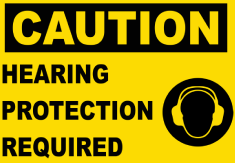Personal Protective Equipment Safety Package
 When it comes to personal protective equipment, or PPE, OSHA requires all employers to conduct a formal written workplace hazard assessment to determine what type(s) of personal protective equipment will be required to protect employees from injuries.
In addition, employers are required to provide appropriate personal protective equipment and conduct employee training on its proper use. Failure to conduct the assessment and certify it is a commonly overlooked requirement.
When it comes to personal protective equipment, or PPE, OSHA requires all employers to conduct a formal written workplace hazard assessment to determine what type(s) of personal protective equipment will be required to protect employees from injuries.
In addition, employers are required to provide appropriate personal protective equipment and conduct employee training on its proper use. Failure to conduct the assessment and certify it is a commonly overlooked requirement.
Most commonly, PPE is used to prevent cuts and lacerations, protection when using chemicals, to help prevent burns, foot injuries, hearing damage or loss, and respiratory damage. The guidance below outlines the steps you need to take toward identifying and understanding common hazards found in your facility, the selection of appropriate PPE, and the management of those hazards in the workplace through training.
PPE Resource Packet
PRINTING United Alliance’s PPE Resource Packet includes a variety of tools for your use in meeting OSHA’s regulatory requirement for this standard and includes the following information:
Written Hazard Assessment Template: OSHA requires all employers to conduct and certify, through a written hazard assessment, the PPE required for each single position. The template provided can be used to correctly determine the hazards associated with each position, not individual employee. This template forms the basis for the documentation of your required hazard assessment.
Safe Dress Code Policy Template: While not an OSHA requirement, consider adopting a Safe Dress Code Policy. This policy template covers general items such as safe dress, long hair, beards, and jewelry that are not covered in the Hazard Assessment Template but can cause accidents in the workplace.
Overview of Hazard Specific PPE
The Sharps Guide is a hazard specific program focusing on common hand protection when working with sharp tools and components typically found in a printing facility. We recommend that it be incorporated into your overall safety program wherever hand protection is found to be necessary. The guide includes:
- Face and Eye Protection: If your assessment indicates face and eye protection is needed, there are a variety of options based on
 the hazard level identified such as flying objects, chemicals, or hazardous light (e.g., UV light or lasers). Spectacles and goggles, personal special helmets or shields, spectacles with side shields, and face shields can protect workers from
the hazards of flying fragments, splashes from chemicals, as well as objects, particles, sand, dirt, mists, dusts, and glare.
the hazard level identified such as flying objects, chemicals, or hazardous light (e.g., UV light or lasers). Spectacles and goggles, personal special helmets or shields, spectacles with side shields, and face shields can protect workers from
the hazards of flying fragments, splashes from chemicals, as well as objects, particles, sand, dirt, mists, dusts, and glare. - Foot and Toe Protection: If your assessment indicates foot protection is needed, there are a variety of options available based on the hazard identified such as crushing, roll over, or dropped objects. Reminder: Employers are not required to provide protective footwear but can require employees to wear safety shoes. Foot guards and safety shoes—including steel-toed boots—can help prevent injuries by protecting workers from hazards such as falling or rolling objects, sharp objects, wet and slippery surfaces, hot surfaces, and electrical hazards.
- Hand Protection: If your assessment indicated hand protection is needed, there are a variety of options available based on the hazard identified. Chemical resistant gloves could be necessary when working with inks and solvents or cut resistant gloves when handling materials with sharp edges or using utility knives.
- Sharps Safety Brochure: An overview of sharps used in the workplace, including a hazard-specific assessment guide.
- Sharps Safety Poster: Serves as a quick reminder of safe operations. Place this poster at or near the areas where sharps are used in your facility.
Hearing Conservation
 Your hazard assessment may indicate employees with exposure to consistent loud noises. This type of exposure, for hours on end, can cause serious hearing damage. It is important to monitor the level of noise in your facility on a regular basis and
protect employees accordingly.
Your hazard assessment may indicate employees with exposure to consistent loud noises. This type of exposure, for hours on end, can cause serious hearing damage. It is important to monitor the level of noise in your facility on a regular basis and
protect employees accordingly.
If your facility includes areas of operation where the noise level equals or exceeds 85dBA time weighted average for 8 hours, then a hearing conservation program is mandatory. If the employee noise exposure exceeds 90dBA time weighted average for 8 hours, then hearing protection is required.
- Written Hearing Conservation Program Template: You can use this template to identify areas of high noise levels, take measures to reduce the noise, and to prevent hearing loss due to noise exposure.
- NIOSH Sound Level Meter App: To conduct noise sampling in your facility, download this App! This app combines the best features of professional sound levels meters and noise dosimeters into a simple, easy-to-use package.
Indoor Air Quality
Our industry uses chemicals. It is important to identify when exposure to chemicals poses a hazard in the workplace. If after  conducting indoor air monitoring, you discover an issue, OSHA first requires the use of engineering controls to control exposures. Engineering
controls includes the use of increased ventilation, worker rotations, etc.
conducting indoor air monitoring, you discover an issue, OSHA first requires the use of engineering controls to control exposures. Engineering
controls includes the use of increased ventilation, worker rotations, etc.
When engineering controls are not feasible, workers must use appropriate respirators to protect against adverse health effects caused by breathing air contaminated with harmful dusts, fogs, fumes, mists, gases, smokes, sprays, or vapors.
The use of respirators by employees requires that all impacted employees need to be medically cleared to wear respirators before commencing use. Users must undergo a fit test to ensure that there is a proper seal between the face and mask and cleaned prior to each use.
Employers who require the use of respirators must develop a written program that includes all required elements of OSHA’s respiratory protection standard. These elements include medical clearance, annual fit testing, and that the respirator is cleaned, stored, and maintained so that its use does not present a health hazard to the user.
Often, employees may wish to use respiratory protection voluntarily. If requested, and you feel that use of a respirator would not create an additional hazard, it is important to understand that all the formal program elements must be implemented. Even for voluntary use, except if dusk masks are used, you must establish and implement the elements of a written respiratory protection program.
- Acknowledgement Form of the Respiratory Standard: The only exception to a formal respiratory program is if an employee wants to voluntarily use a dust mask. It is required that all employees who wish to voluntarily wear respirators be provided a copy of Appendix D from the standard. The employee needs to sign the acknowledge form below.
PRINTING United Alliance’s Safety and Health Resource Center provides technical assistance and services designed to allow printing operations to manage compliance and stay informed. For more information on Personal Protective Equipment or PRINTING United Alliance’s EHS services, email govtaffairs@printing.org or call 888-385-3588.